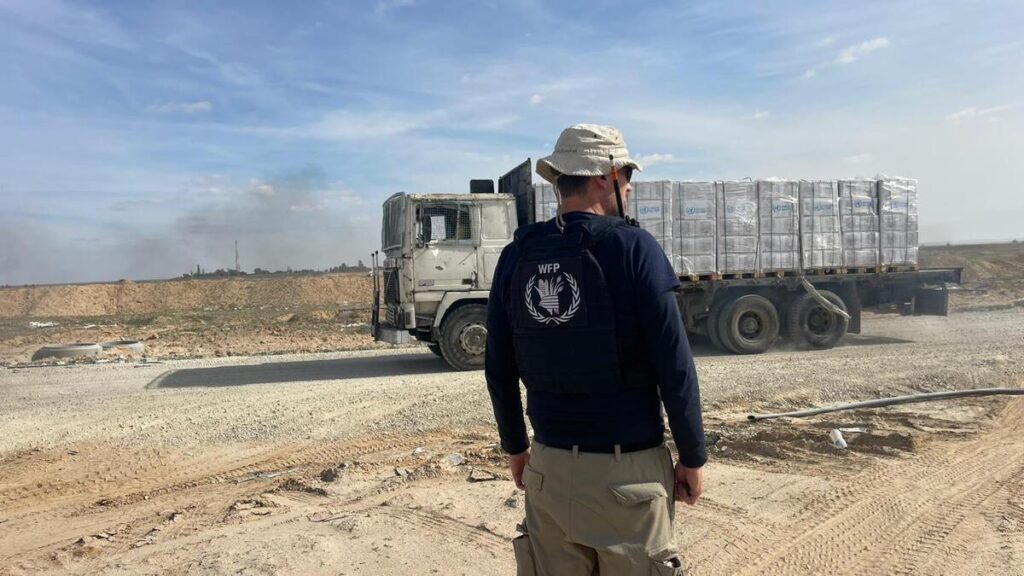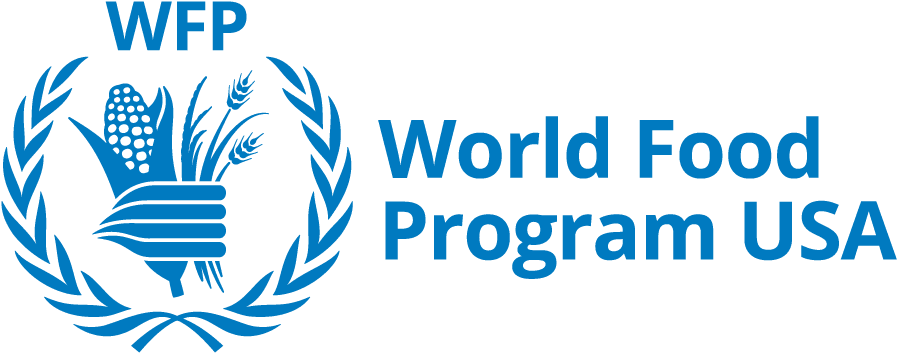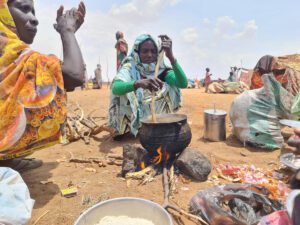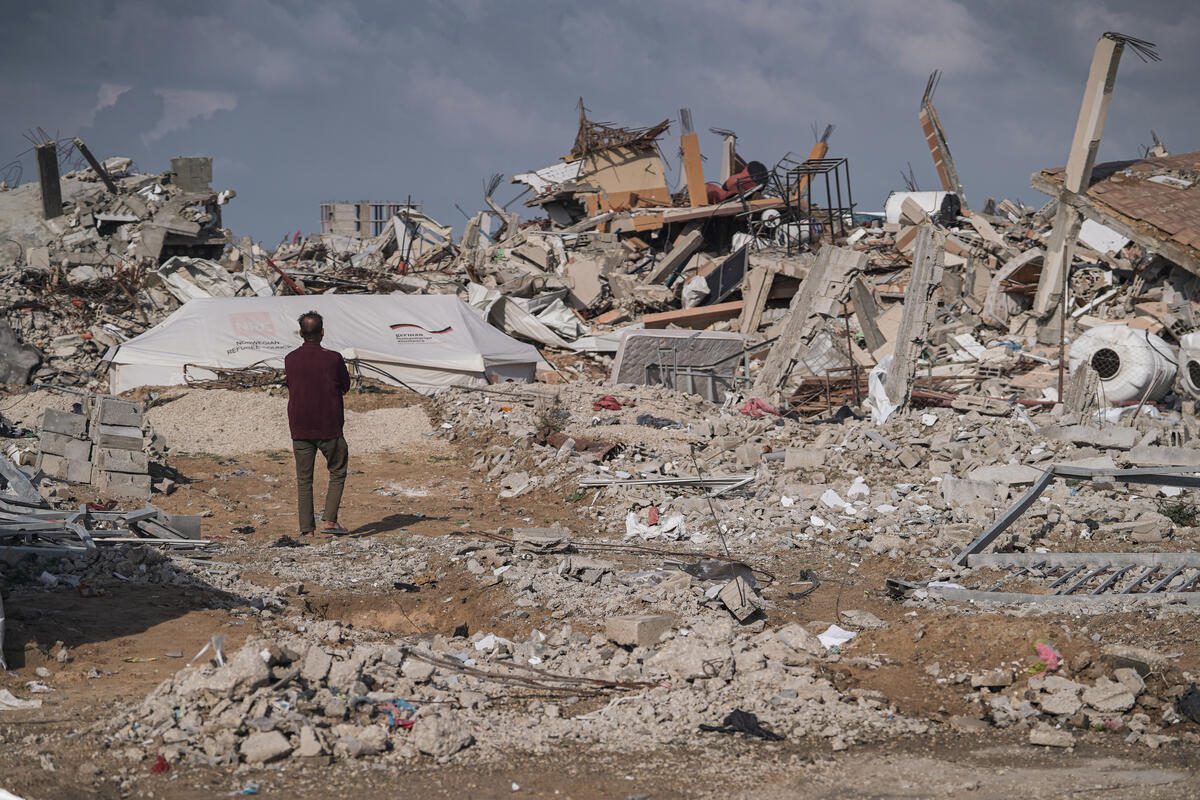A humanitarian catastrophe continues to unfold in Gaza. As the conflict evolves and escalates, more and more people suffer from displacement and starvation. Today, 90% of the population is displaced, and every person is experiencing hunger. There is a risk of famine across the Gaza Strip.
The World Food Programme (WFP) has worked in Gaza since 1991 and scaled up its emergency relief efforts in response to this latest crisis. Here’s a closer look at how this hunger emergency has unfolded and WFP’s response.
Escalation of Conflict
The escalation of conflict in October 2023 caused the destruction of infrastructure and entire neighborhoods in Gaza. U.N. partners reported damage to several healthcare facilities and United Nations Relief and Works Agency (UNRWA) schools that now serve as shelters for displaced families. Many shops where people could redeem WFP vouchers to buy food were destroyed.
In the immediate aftermath of the first air raids, WFP began distributing fresh bread, canned food and ready-to-eat food to around 100,000 people who sought refuge in UNRWA shelters.
Humanitarian Aid Enters Gaza

Children celebrate the arrival of a UN truck at an emergency shelter in Gaza.
In the first week of our emergency response, the borders into Gaza were closed, preventing humanitarian aid from entering. However, WFP was able to distribute a limited amount of food from its warehouses inside Gaza.
October 21, 2023: The opening of the border crossing between Egypt and Gaza enabled the first convoy of trucks to bring in urgently needed food, water and other supplies provided by the Egyptian Red Crescent and the United Nations for hundreds of thousands of people who had been struggling amid desperate conditions. The convoy, which moved through the Rafah crossing, brought with it three trucks carrying over 130,000 pounds of emergency food.
Conflict & Hunger Cause Desperation
The ongoing conflict and chaos in Gaza took a severe toll on civilians and aid workers.
October 30, 2023: Thousands of people stormed a U.N.-run warehouse in central Gaza where WFP was storing food commodities.
“This is a sign of people losing hope and becoming more desperate by the minute. They are hungry, isolated, and have been suffering violence and immense distress for three weeks,” said WFP Representative and Country Director Samer Abdeljaber.
The morning’s events followed a harrowing 24-hour communication blackout and persistent access challenges that brought all WFP operations to a halt, leaving staff and partners disconnected.
Breakthroughs in Food Relief

Displaced families in U.N. shelters receive daily bread, canned food and/or date bars.
November 26, 2023: During a weeklong pause in fighting, WFP scaled up and delivered desperately needed food to more than 120,000 people in Gaza. This aid included over 16,500 pounds of food delivered by an interagency convoy to around 23,616 people in Al-Ahli hospital and surrounding hard-to-reach areas. Yet, it was not enough to meet the needs of over 2 million people who needed aid, and resumed fighting put food security progress at risk.
December 20, 2023: A 46-truck convoy, organized by WFP and the Jordan Hashemite Charity Organization (JHCO), carried more than 1.65 million pounds of lifesaving food into Gaza, marking the first time a direct aid convoy from Jordan had reached the Gaza Strip since the surge in hostilities began in October. After 10 weeks of the crisis in Gaza, half of the population faced starvation, with little access to food, water and shelter.
Conflict and Hunger in Gaza Increase
December 21, 2023: An Integrated Food Security and Nutrition Phase Classification (IPC) report confirmed the entire population of Gaza – roughly 2.2 million people – faced crisis levels of hunger or worse. Of those 2.2 million people, 576,600 faced catastrophic hunger and starvation. The report warned of the risk of famine, unless access to adequate food, clean water, health and sanitation services was restored.
January 15, 2024: Since the humanitarian pause in November, food had not been able to reach northern Gaza. For the first time since that pause, the WFP’s food convoy entered northern Gaza and delivered food supplies for around 8,000 people.
Challenges and Barriers to Humanitarian Aid

WFP helps provide hot meals that are distributed to internally displaced people in U.N. shelters and across distribution points.
In order for food aid to reach people in Gaza, there needs to be a consistent flow of trucks across the border and safe passage to their destinations. However, closed border crossings had prevented dozens of trucks – full of aid – from entering for weeks. When they were able to get through, convoys faced many challenges to deliver aid including a lack of security.
January 2024: With only two open border crossings into Gaza, both on the Egyptian side, and lengthy checks on the Gaza side, bottlenecks stopped WFP in its tracks. Drivers stood outside in the narrow lanes formed between the lines of trucks, prepared to go at any moment.
By late January, 120 trucks, including 73 WFP trucks, had managed to pass through the Rafah border crossing. This is significant: Two weeks prior, only 60 to 80 vehicles were getting through. The increase was the result of a new inspection point just two miles from the Rafah border. Everything that crossed through underwent extensive inspection.
By the end of January, despite challenges, WFP had delivered the highest amount of food to Gaza since the start of the crisis: 48M pounds of food for 1.4 million people.
February 18, 2024: The plan was to send 10 trucks of food for seven straight days. However, on Sunday, as WFP started the route towards Gaza City, the convoy was surrounded by crowds of people desperate for food. First fending off multiple attempts by people trying to climb aboard our trucks, then facing gunfire once we entered Gaza City, our team was able to distribute a small quantity of the food along the way. The next day, the second convoy’s journey north faced chaos and violence due to the collapse of civil order. On February 20, WFP paused food deliveries to northern Gaza until safe passage could be secured.
Finding Ways to Get Food into Gaza

Children receiving date bars from WFP staff in Gaza. Their house was hit and left in rubble, except for one room where they decided to stay.
March 5, 2024: A 14-truck food convoy – the first by WFP since it was forced to pause deliveries to the north on February 20 – was turned back by the Israeli Defense Force after a three-hour wait at the Wadi Gaza checkpoint. After being turned away, the trucks were rerouted and later stopped by a large crowd of people who desperately took around 450,000 pounds of food from the trucks. With so few food deliveries due to limited access, people will do whatever it takes to feed their families.
After these setbacks in delivering aid to northern Gaza, WFP turned to air drops. With the help of the Royal Jordanian Air Force, WFP air dropped enough food into northern Gaza for nearly 20,000 people. However, knowing that trucks are the most effective and reliable method for food delivery, WFP strengthened its call for safe land access.
March 18, 2024: WFP delivered 18 truckloads of food supplies to Gaza City. The convoy, the second to use a coordinated route into Gaza City and the north, delivered 600,000 pounds of wheat flour, food baskets and ready-to-eat rations. Dispatching aid to the north of Gaza required day-to-day approvals from Israeli authorities. During the long waits at the Wadi Gaza checkpoint, truck convoys faced lootings and were frequently turned back. If they did get through, there was a high risk of more looting along the difficult route north.
Tragedy and Setbacks for Humanitarian Efforts
April 1, 2024: Seven World Central Kitchen humanitarian workers were killed by an airstrike. Their deaths brought the total number of humanitarian workers killed in Gaza to nearly 200 in just six months, far higher than any other modern conflict.
May 6, 2024: Both the Kerem Shalom and Rafah crossings, the only two entrances into Gaza from the south, were closed. This, in combination with escalation of military activity in Rafah, put civilians at higher risk of hunger.
Ceasefire and Safe Passages Are Needed

Ibrahim and his family were displaced on the very first day of the war on Gaza, and have been displaced since then for five times. “We know it’s not safe in here, but we have nowhere else to go anymore” says Ibrahim. In order to sustain himself and his children, Ibrahim relies on the food aid he receives from WFP.
May 15, 2024: After months without access, a new coordinated route to the north, plus use of the Erez crossing and the Ashdod port, allowed WFP to double the amount of aid that was delivered in April to northern Gaza.
June 16, 2024: As fighting escalated in southern and central Gaza, the toll on civilians was devastating. The hostile operating environment made it nearly impossible for humanitarian operations to deliver desperately needed food.
“It is getting harder to do our job. Staff spend five to eight hours waiting at checkpoints every day. Missiles hit our premises, despite being deconflicted. The breakdown of law and order means we also face looting and violence amid a large security vacuum,” said Carl Skau.
In northern Gaza, there were improvements in assistance where WFP and partners could deliver supplies through West Erez crossing.
August 27, 2024: A WFP team was returning from a mission when it came under fire near an Israeli checkpoint. Despite the trucks being clearly marked and receiving multiple clearances by Israeli authorities to approach, the vehicle was directly struck by gunfire as it moved towards an Israeli Defense Forces (IDF) checkpoint.
Ceasefire Opens Doors for Relief

January 19, 2025: On January 19, a long-awaited ceasefire went into effect and WFP trucks immediately crossed into Gaza carrying ready-to-eat meals and bags of wheat flour. The ceasefire allowed WFP to bring in urgently needed food aid at scale and begin pulling the war-ravaged territory back from starvation.
January 28, 2025: In the first week of the ceasefire, WFP reached more than 330,000 people with food boxes, hot meals and cash assistance. Through all available corridors from Jordan, Israel and Egypt, WFP flooded Gaza with aid and brought in over 22 million pounds of food into Gaza. For the first time in months, families in Gaza received significantly more rations – two food boxes and a 55-pound bag of wheat flour.
Borders Closed to Humanitarian Aid
March 2, 2025: In the 42 days of the ceasefire starting January 19, WFP delivered over 88 million pounds of food into Gaza and provided lifesaving assistance to 1.3 million people. On March 2, border crossings were closed to humanitarian and commercial supplies. WFP had enough food stocks inside Gaza to support kitchens and bakeries for up to one month, as well as enough ready-to-eat meals for 550,000 people for two weeks.
April 25, 2025: By April 25, WFP delivered its last remaining food stocks to hot meal kitchens in the Gaza Strip. All 25 WFP-supported bakers shut down due to the lack of flour and fuel. With no humanitarian or commercial supplies entering Gaza, the situation once again reached a breaking point.
May 12, 2025: An IPC report said hunger and malnutrition had intensified sharply since all aid was blocked from entering on March 2. A risk of famine persisted across the Gaza Strip as fighting surged again, border crossings remained closed and food stays dangerously scarce.
Limited Aid Allowed Into Gaza

May 19, 2025: Israel announced it would temporarily allow a limited amount of aid into Gaza, following 11 weeks of complete blockade. By May 21, border crossings reopened, and a handful of WFP-supported bakeries in south and central Gaza quickly resumed production after dozens of trucks were able to collect and deliver cargo. Vital convoys were able to enter Gaza carrying wheat flour and resources to support kitchen operations for hot meals as well as nutritional supplements and medical supplies.
Need for Safe Access and Operations Resume
May 23, 2025: Fifteen WFP trucks were looted en route to WFP-supported bakeries. These trucks were transporting critical food supplies for populations waiting anxiously for assistance. Then, on May 29, people broke into the WFP Al-Ghafari warehouse in Deir Al-Balah in central Gaza in search of food supplies that were pre-positioned for distribution. Initial reports indicated that two people died and several were injured in the tragic incident.
July 20, 2025: On the morning of July 20, a 25-truck WFP convoy carrying vital food assistance crossed the Zikim border point destined for starving communities in northern Gaza. Shortly after passing the final checkpoint beyond the Zikim crossing point into Gaza, the convoy encountered large crowds of civilians anxiously waiting to access desperately needed food supplies. As the convoy approached, the surrounding crowd came under fire from Israeli tanks, snipers and other gunfire. WFP continued to call for the protection of all civilians and aid workers delivering lifesaving assistance.
Gaza’s hunger crisis has reached new levels of desperation. People are dying from lack of humanitarian assistance. WFP is ready with food supplies nearby, experienced teams on the ground and proven systems in place to respond at scale. The risk of famine remains extremely high, which is why we continue to call for an immediate ceasefire and for the safe passage of our staff. Civilians and humanitarians must be protected.





